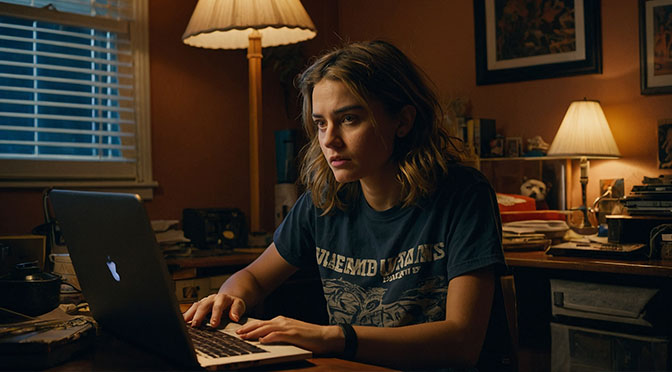Imagine writing a story where love isn’t sparked by touch but by gazes across a screen. The webcam becomes a window of desire, a portal connecting two people separated by miles. For young writers of erotic literature, a long-distance relationship offers a captivating playground: it’s the perfect stage for tension, yearning, and – as every good story demands – conflict.
Scene 1: The First Connection
The setting: A small, cluttered room lit by a desk lamp casting warm shadows on the walls. She’s in her mid-twenties, with tousled hair and an old band T-shirt, sitting at her laptop. Her eyes gleam with curiosity as she sips nervously from a glass of wine. On the other side of the screen: Him, lean, with a three-day stubble and a smile that’s both shy and daring. His background is a bare wall – maybe a hotel room, maybe a shared flat. The distance between them is palpable, but the webcam bridges it with every breath.
They start with small talk, but the conversation quickly turns intimate. “What are you wearing beneath?” he asks, his voice deep and rough. She laughs, lifts her shirt slightly, revealing the edge of her stomach – flat, with a fine line of hair trailing downward. Psychologically, she’s torn: she wants to open up, but insecurity gnaws at her. Is this safe? Is he real? He, meanwhile, wrestles with impatience – he wants to see more, know more, but senses he can’t push her.
Tip for Writers: Start with the details – the texture of the clothes, the timbre of the voice, the tiny gestures. Let readers feel the tension between closeness and distance. Use the webcam as a symbol of intimacy and a barrier at once.
Scene 2: The Sextalk
A few video calls later, things get bolder. The light is dimmed, her skin glows in the flicker of a candle. She whispers, “Tell me what you’d do to me if you were here.” His reply is precise, unhesitating: “I’d slide my fingers down your neck, to your breasts, and slowly unhook your bra.” Her breasts are small, the nipples dark and sensitive – she describes them to him, shamelessly, as she pulls the shirt over her head. He leans closer to the camera, his breath fogging the mic as he says, “I want to see your lap.” Her panties slip lower, revealing the soft curves of her hips and the narrow strip of pubic hair between her thighs.
Psychologically, it’s a dance of control and surrender. She revels in the power she holds over him, while he squirms in his helplessness, unable to touch her. Words become their hands, the camera their eyes.
Tip for Writers: Be specific yet poetic. Describe body parts like landscapes – the curve of a spine, the gentle dip of a collarbone. Avoid crude terms; try “Her skin shone like polished marble” instead of “She was naked and hot.” Let the dialogue breathe – make it sound real, with pauses and stumbles.
Scene 3: The Slow Undressing
Now it gets visual. She stands, turns before the camera, letting her panties fall to the floor. Her legs are long, the insides of her thighs slightly flushed from sitting. He sheds his shirt, revealing a chest dusted with fine hair and a stomach that’s not perfectly toned but firm. His penis, half-erect, appears as he opens his pants – a natural reaction, described without judgment, just part of the moment. She chuckles softly as she leans forward, her breasts swaying slightly, the tips hardened with arousal.
The webcam captures every detail, and that’s what makes the scene electric – the closeness that isn’t quite real. They see each other, hear each other, but they can’t smell or taste. That’s the core of the erotic tension.
Tip for Writers: Use the senses that remain – sight and sound. Describe the rustle of fabric, the soft gasp. Make readers feel the frustration of distance – that’s your conflict engine.
The Conflict: Hackers and the Danger
But every good story needs drama, and here’s where danger enters. Imagine a hacker gains access to their webcam session. Maybe they record the intimate moments, or later find the files on her laptop. The protagonists suspect nothing until an anonymous link lands in her inbox – a video exposing their vulnerability. Shame, anger, and fear erupt. She wonders, “How did this happen?” He feels guilt: “Did I push her into this?”
Dramaturgically, you can play this in many ways: Does the video leak, forcing them to face the fallout? Blackmail by the hacker as a plot twist? Or do they uncover the culprit and seek revenge? The conflict is existential because it threatens their intimacy, their trust – the essence of their bond.
Tip for Writers: Build the danger subtly – a shadow in the background, an odd noise from the speaker. Let readers sense it before the characters do. Conflict isn’t an accessory; it’s the heartbeat of your story. Without it, the tale falls flat.
Wrap-Up: Dramaturgical Possibilities
- Option 1: They overcome the distance, finally meet – but the recorded session looms like a sword of Damocles.
- Option 2: The hacker becomes a third character, a voyeur steering the story into darker territory.
- Option 3: They use the threat to strengthen their bond – the danger becomes a catalyst for courage and devotion.
Tip for Writers: Experiment with perspectives. Write a scene from the hacker’s view – what do they see, feel? Or switch between their thoughts to show emotional depth. Describe bodies and acts without censorship but with respect – they’re tools of the narrative, not taboos.
Writing Prompt
“Write a scene where two lovers, separated by an ocean, undress for the first time on webcam. An unexpected sound makes one pause – just the wind, or is someone listening? Describe their bodies, words, and growing unease without breaking the eroticism.”

